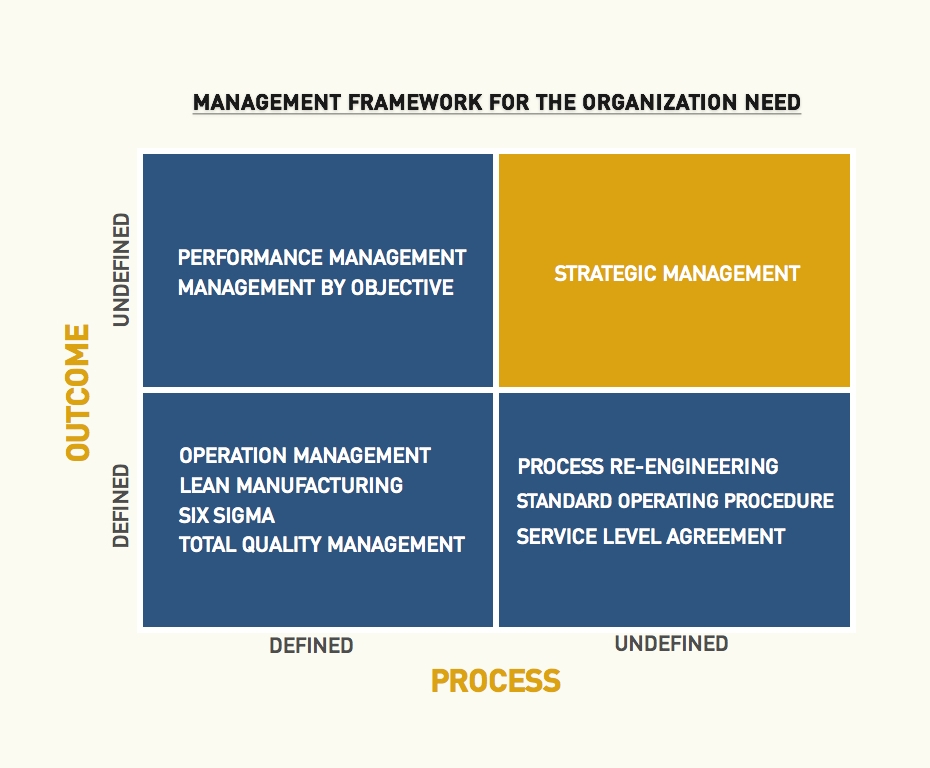MANAGEMENT FRAMEWORK FOR THE ORGANIZATION

BY DR. TANAI CHARINSARN
OCTOBER 25, 2016
Managing organizations with varying levels of ambiguity can be done in several ways. Typically, each organization tends to choose different strategies. The framework of this article is derived from examining the management concepts of organizations that have different processes and outcomes in their operations, which depend on the nature of each organization.
Defining a management framework suitable for each business type will enable strategists and managers to efficiently choose the tools for managing their organization. They can focus on the essential tools for the organization without wasting time on unnecessary matters, as the business world is constantly evolving and never stands still. Wasting time on unnecessary matters may lead the organization astray and make it difficult to recover.

Management Framework
If we evaluate the characteristics of organizations based on the clarity of their "process" and "results," we can identify four patterns:
-
Organizations with clear work processes and performance measurement: We often observe this type of organization in large industrial manufacturing businesses, such as automobile part production, ready-to-eat food production, and paper manufacturing. These organizations have well-defined work processes and clear performance metrics, such as production quantity per time period, production quality according to standards, or revenue per production cycle. Management concepts suitable for this type of organization include Total Quality Management (TQM), Operation Management, Six Sigma, and Lean Manufacturing, which enhance work process efficiency and lead to desired outcomes. These organizations can track and monitor work results effectively, fostering competitiveness and profitability. Examples include Toyota and CPF Corporation.
-
Organizations with clear work processes but unclear performance measurement: Government systems are a good example of organizations falling into this category. They have well-structured work processes, document formats, and systematic workflow, but they often lack clear criteria for measuring work success. For example, government offices, transportation agencies, and document processing services may have clear processes, but they don't specify measurable outcomes. Management approaches for such organizations include Performance Management and Management by Objectives (MBO), which help employees work toward specific goals. Common tools in this category are Key Performance Indicators (KPIs) and the Balanced Scorecard. Examples include government agencies and banking institutions.
-
Organizations with unclear work processes but clear performance measurement: Small businesses often fall into this category, particularly when the business owners set their goals and outcomes without clearly defined work processes. Without established processes, these organizations cannot confirm their success due to the lack of systematic work. To address this, they need to establish work processes and standards. Management concepts for such organizations include Process Re-engineering, Standard Operating Procedures (SOPs), and Service Level Agreements (SLAs) to control and standardize their work processes and create agreements about the work scopes for each department within the organization. Examples include small and medium-sized enterprises (SMEs).
-
Organizations with unclear work processes and unclear performance measurement: This category typically includes new organizations or those undergoing significant changes in direction and operations. Start-ups and organizations with changing management may need to rely on strategic management concepts to plan and set the direction for their work. This helps unify the organization's vision and goals, even when work processes and outcomes are not yet clear. It's crucial for each organization to understand its current state and the nature of its business to choose the right management tools and ensure effective management within the organization.
Understanding the organization's current situation and having a clear view of its business characteristics allows each organization to choose the appropriate management tools and truly improve organizational management efficiency.
